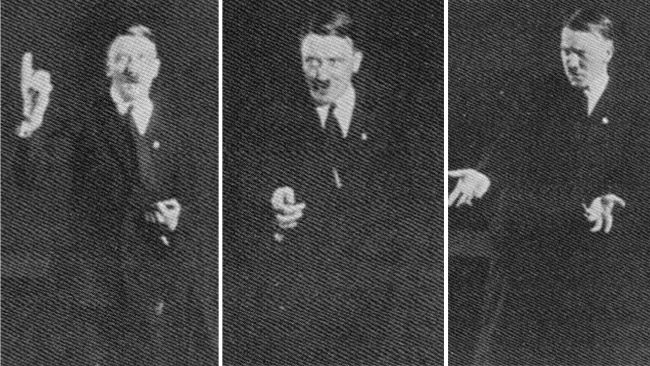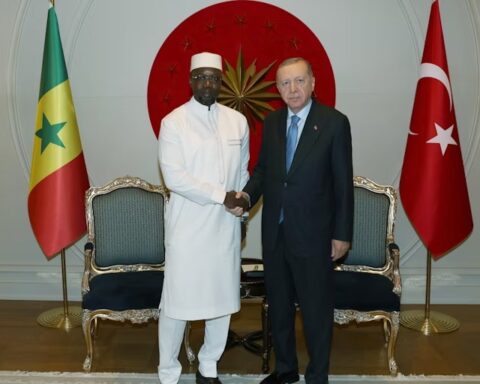In his living room, studded with signed photographs of the rich and famous, Henk Visser, the arms collector and businessman, once told me about his wartime experience. Barely eighteen years old, he had joined the Dutch resistance, was captured by the Germans and sentenced to death. While he was awaiting his execution, his mother wrote a letter to Hitler, begging him not to have her son executed. Hitler granted the request and Henk Visser survived.
This simple anecdote serves to illustrate that Hitler was not the crazed, bloodthirsty monster he is made out to be in the prevailing narrative on the 1930s and 1940s. Such anecdotes compel us to reconsider the concepts and facts that constitute our frame of reference and that consequently determine and shape the way we think, talk and act. The most important events and historical figures are multifaceted, but for clarity’s sake have been narrowed down to one-dimensional proportions.
Whereas history has many protagonists who, to say the least, are controversial, none of them has been vilified to the extent to which Hitler has virtually become the devil incarnate. This may be due in large party because as the leader of Germany, Hitler fought the British Empire and the US. In other words, he was the enemy of the Anglosphere, which would explain the negative image imposed on the world during and especially after the war. More than one century earlier, Napoleon was another sworn enemy of the Anglosphere and one could say that before Hitler appeared on the stage, he was the favorite bad guy. Not in France though. Nor did the English outlaw any references to Napoleon after they invaded Paris after the Battle of Waterloo.
Hitler shares with Napoleon the distinction of being a fascinating subject for biographers, but most are unable to resist the pressures to paint a fundamentally negative portrait. Among biographies of Napoleon on the other hand, there is an impressive number of positive and benevolent studies, outnumbering the negative ones, and this is certainly the case for France.
In the American Empire, Hitler is the embodiment of evil. One might even say he is the negative parallel to Jesus Christ, the Son of God. Hitler would then be the son of the devil, while the satanic equivalent of the Holy Ghost would then be the ideology of National Socialism. The Holy Bible of that evil religion consists of Hitler’s Mein Kampf (the “Old Testament”) and Alfred Rosenberg’s Der Mythus des 20. Jahrhunderts (the “New Testament”). As a matter of fact, given the frequency with which since 1945 “New Hitlers” have been identified by American and other Western politicians, “experts” and journalists, proves that there is indeed a religious aspect to the way Hitler is being considered. The determination with which Russia is currently pursuing its goal to “denazify” the Ukraine is an indication that the American way of looking at the issue is shared in Moscow.
As my former professor at the University of Florida, Lyle N. McAlister, would tell say, history is like a store or supermarket, where “you pay your money and you make your choice.” He was referring to interpretations of historical facts and figures, indicating that it is often just impossible to prove anything without a shadow of a doubt, and that in the end, historical interpretations are subjective.
The more recent the past, the harder to study it. The very proximity and the wealth of fresh memories and primary sources are at the same time obstacles for anyone attempting to gain a comprehensive understanding. The sheer act of selecting and locating the sources needed for answering any question will always take considerable time. Historical research on the Second World War is therefore time consuming. The quantity of primary and secondary sources is truly overwhelming.
In history, like in detective work, it is best to start out with some relevant, basic questions. For the sake of clarity and in order to preserve academic rigor, those questions should be simple and straightforward, and not implicitly assume anything beforehand. So one should never start with asking “how” and “why,” since these can only be dealt with after answering the questions of “who,” “what,” “where” and “when.” By the way, most contemporary historical research precisely starts out with asking how and why, making its results more than often shaky and doubtful.
Concerning Hitler, the questions could be the following: 1) Who was Hitler, and what are his roots? 2) Who helped Hitler come to power? 3) What was his policy towards the Jews and who benefited from these? 4) Did he start World War II? and 5) What happened to Hitler after the German defeat in 1945?
Each of these questions has several possible answers and these can be found in the available literature on Hitler, the Second World War and the Interwar period. However, in the more or less unified historical narrative in the US Empire (comprising essentially the EU and the Anglosphere), the answers are simple and one-sided. Basically, these are the answers: 1) A lower-class political adventurer and failed artist from Austria, 2) Hitler came to power riding on a wave of frustration and Right-Wing extremism, 3) Hitler wanted to kill all the Jews, 4) yes, and 5) he committed suicide.
It must be doubted if these standard answers, woven into the standard narrative, are the truth, the whole truth and nothing but the truth. Let us take a look at them one by one.
Who was Hitler, and what are his roots? In the first place, one should read Hitler’s book Mein Kampf, but it is not readily available in many Western countries. Then there are hundreds of biographies of Hitler, usually in the form of sturdy volumes, but only a few of these present a non-mainstream-approved picture. The best of these is probably Hitler’s War by David Irving, based on a wealth of sources and interviews, and which shows that Hitler was a complex, highly intelligent, politically savvy individual, who took pains to present a solid, reliable and inspiring public image, and worked relentlessly to serve his country the best he could.
In 2005 New Zealander Greg Hallett published Hitler was a British Agent. Altough replete with typos and information that upon closer scrutiny often seems wrong, incomplete or twisted, on the whole the book deserves attention if only because if its premise is true, a number of what are now still mysteries during Hitler’s reign become understandable and might be fitted into a broader scheme. Hallett’s proposition is upheld by a scholar specialized in financial history: Guido Giacomo Preparata, who in 2005 published Conjuring Hitler. How Britain and America Made the Third Reich. Based on solid research, reliable sources and benefiting from an understanding of the banking world that no ordinary historian can muster, Preparata offers a strong case, which it makes it difficult to reject out of hand. Therefore it is altogether not unlikely that Hitler was not acting in the interest of Germany alone, but that he was directed by powerful groups in London and New York. If such should be the case, most of what has been written about Hitler and the Second World War can be put in the shredder. At the same time this makes it understandable that powerful interests ignore the work by Preparata and Hallett, qualifying it as lunatic conspiracy theories. In this respect one should also refer to the seminal work by Carroll Quigley, The Anglo-American Establishment. From Rhodes to Cliveden (1981), who based on extensive research shows that German policies under Hitler were in the British interest. Argentinian researcher Abel Basti has made a big effort to unravel several mysteries surrounding Hitler, and also adheres to the version that Hitler and the Nazis cooperated with the US as well as Zionists (Los secretos de Hitler. Los acuerdos de los nazis con los Estados Unidos y los sionistas, y los rastros en la Argentina del Jefe del Tercer Reich, Buenos Aires, 2011).
In itself it makes sense to suppose that Hitler enjoyed the support of powerful groups and individuals when embarking on his political career. Such was notably also the case with another political outsider, namely Vladimir Zelensky in the Ukraine. In 2015 he starred in the TV series Servant of the People, (running for three seasons) in which he played a high school history teacher who was catapulted to national fame and then ran for president, winning the election.
If Hitler was being directed by foreign political and financial interests, these would have included some highly influential Jews as well. This brings us to the Jewish Question and Hitler’s policies. Frankly speaking, much of Hitler’s prewar Jewish policies were quite welcome to German and international Jews. The Nuremberg racial laws prohibiting marriages between Germans and Jews was welcomed not only by fanatical Nazis and Germans with a dislike for Jews, but especially by conservative rabbis. In other words, they felt Hitler was doing a service to the Jewish community. However, this savory and very important detail is scrupulously avoided in the standard narrative.
Another aspect missing in the standard narrative is the formal cooperation between the Nazis and the growing Jewish settler community in Palestine. Known as the Haavara Agreement, this cooperation enabled German Jews to settle in the Holy Land, after selling their property in Germany and depositing the proceeds in German banks. Once in Palestine, they could buy the machinery and equipment they needed, and which was produced in Germany (Edwin Black, The Transfer Agreement. The Dramatic Story of the Pact Between the Third Reich and Jewish Palestine, New York, 1984). Also left out of the standard narrative is the fact that young Polish Jews were receiving military training in Poland before moving to Palestine (see L. Weinbaum, A marriage of convenience. The New Zionist Organization and the Polish Government 1936–1939, New York 1993).
In short, the standard narrative almost exclusively focuses on the antagonistic aspects of the complex relationship that Hitler had with the Jews. Quite apart from the rumors that Hitler had himself Jewish ancestors, his attitude seemed determined by his understanding that there were intimate connections between the Jews and Freemasonry, which he abhorred and tried to eliminate (Arnaud de la Croix, Hitler et la franc-maçonnerie, Brussels, 2013).
As for the question who started World War Two, the answer given by standard historiography is clearly wrong. That war began only when on September 3, 1939 England and France declared war on Germany, after it had invaded Poland two days before. That formal declaration brought the French and English colonial empires (including Canada, Australia, New Zealand, South Africa, India, Indochina, Algeria, Morocco and much of the rest of Africa) into the war, turning a purely European conflict into a World War.
Finally, standard historiography is unequivocal about Hitler’s fate at war’s end: he committed suicide in the Führerbunker in Berlin as Red Army troops were moving into the city. The German movie Der Untergang (Downfall, 2004), winning prizes and captivating audiences worldwide, served as a resounding confirmation of the official narrative. Yet there are many indications that Hitler managed to leave Berlin before the Red Army had conquered the city. Greg Hallett claims he was flown to Barcelona, Spain, where he died in 1950. There have long been persistent rumors and quite a bit of secondary evidence (much of it shaky) that Hitler instead fled to Argentina. These rumors began to circulate immediately after the war and Abel Basti has devoted much time and effort to scrutinize these and publish his findings.
Argentinian economist Walter Graziano has further developed the notion that Hitler was somehow an instrument of foreign financial and political interests and has tried to show to what extent Hitler’s economic and administrative policies were continued after the war. In Hitler ganó la guerra (2nd edition, 2008), Graziano argues that the Third Reich was just another necessary step in line with the plans by a small clique to govern the world. He considers the Council on Foreign Relations, the Bilderberg Group and the Trilateral Commission, with their efforts to create a New World Order, as heirs to among others the Thule Society (some of whose members were Hitler’s confidantes) and the Third Reich. Graziano also discerns a continuum going back to the late-eighteenth century.
One has to conclude that, as is the case with many very important historical figures, there is not just one Hitler. The Hitler of official historiography is only one of them. There is the alternative Hitler, the one who had quite a complex, multi-layered personality and who also may or may not have served primarily non-German interests and then fled abroad. One should also bear in mind that, like some other important political personalities (Stalin, Albania’s Enver Hoxha, Saddam Hussein, etc.) Hitler had doubles, or political decoys. Thus, when the real protagonist dies or exits from the stage, this tends to be a surrounded by a cloud of doubts and uncertainties that may take a long time to subside. Now that almost a century has passed since Hitler disappeared it is becoming increasingly evident that picturing him as the son of Satan can have no basis in fact.
It would be a tremendous benefit if the fundamentally one-dimensional image of Hitler would be replaced by a historically more correct one. However, the prevailing political structure of much of the world prevents this for the time being.
On the other hand, unbeknownst to most of the world’s population, there is a third Hitler, no longer the one considered as the Savior of Germany in the interwar years, but as the potential savior of the world. This is the Hitler as avatar of the Hindu Deity Vishnu, a concept first developed in the 1930s by Savitri Devi. Chilean diplomat and author Miguel Serrano further elaborated this idea of Esoteric Hitlerism, suggesting that Hitler was the Messias destined to restore the ancient religion of the Aryans.
In the end, the fact that apart from the Hitler of official history (and who is intrinsically transcendent because of his non-official status as the son of Satan), there are two other Hitlers, essentially means that our rulers have failed in their control of the historical narrative.
Note that the third Hitler is a Divinity.
Now isn’t that interesting? It would seem that when you want to turn somebody into a devil, he actually becomes the opposite!
Source: https://hansvogel.substack.com/p/three-hitlers






